Early fluid loading in acute respiratory distress syndrome with septic shock deteriorates lung aeration without impairing arterial oxygenation: a lung ultrasound observational study
- PMID: 24887155
- PMCID: PMC4055974
- DOI: 10.1186/cc13859
Early fluid loading in acute respiratory distress syndrome with septic shock deteriorates lung aeration without impairing arterial oxygenation: a lung ultrasound observational study
Abstract
Introduction: The study was designed to assess the impact of fluid loading on lung aeration, oxygenation and hemodynamics in patients with septic shock and acute respiratory distress syndrome (ARDS).
Methods: During a 1-year period, a prospective observational study was performed in 32 patients with septic shock and ARDS. Cardiorespiratory parameters were measured using Swan Ganz (n = 29) or PiCCO catheters (n = 3). Lung aeration and regional pulmonary blood flows were measured using bedside transthoracic ultrasound. Measurements were performed before (T0), at the end of volume expansion (T1) and 40 minutes later (T2), consisting of 1-L of saline over 30 minutes during the first 48 h following onset of septic shock and ARDS.
Results: Lung ultrasound score increased by 23% at T2, from 13 at baseline to 16 (P < 0.001). Cardiac index and cardiac filling pressures increased significantly at T1 (P < 0.001) and returned to control values at T2. The increase in lung ultrasound score was statistically correlated with fluid loading-induced increase in cardiac index and was not associated with increase in pulmonary shunt or regional pulmonary blood flow. At T1, PaO2/FiO2 significantly increased (P < 0.005) from 144 (123 to 198) to 165 (128 to 226) and returned to control values at T2, whereas lung ultrasound score continued to increase.
Conclusions: Early fluid loading transitorily improves hemodynamics and oxygenation and worsens lung aeration. Aeration changes can be detected at the bedside by transthoracic lung ultrasound, which may serve as a safeguard against excessive fluid loading.
Figures

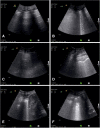
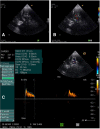
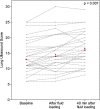
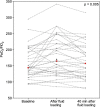
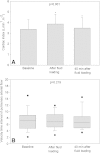
References
Publication types
MeSH terms
LinkOut - more resources
Full Text Sources
Other Literature Sources

